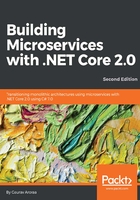
Transitioning to our product service
We already have our product module in place. We are going to pull back this module now and start with a new ASP.NET Core MVC project. To do this, follow all the steps we discussed in the preceding sections and in Chapter 1, An Introduction to Microservices, Let's examine the technology and database we will use:
- Technology stack: We have already selected this for our product service; we will go with ASP.NET Core, C#, Entity framework (EF), and so on. Microservices can be written using different technology stacks and can be consumed by clients created by different technologies. For our product service, we will go with ASP.NET Core.
- Database: We have already discussed this in Chapter 1, An Introduction to Microservices, when talking about a monolithic application and segregating its database. Here, we will go with SQL Server, and the database schema will be Product instead of dbo.
Our product database is segregated. We will use this database in our product service, as shown in the following screenshot:

We have created a separated product database for our product service. We did not migrate the entire data. In the following sections, we will discuss product database migration as well. Migration is important as we have numerous existing records of FlixOne bookstore customers. We can't ignore these records, and they need to be migrated to our modified structure. Let's get started.